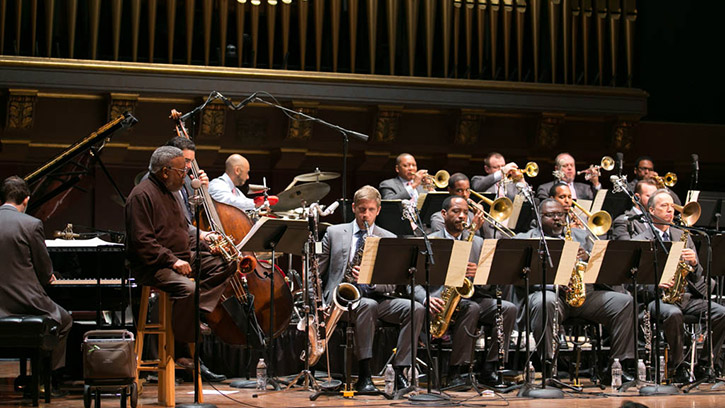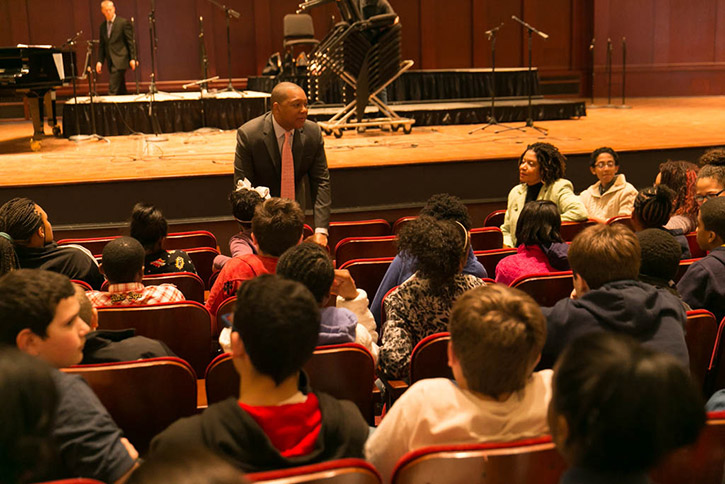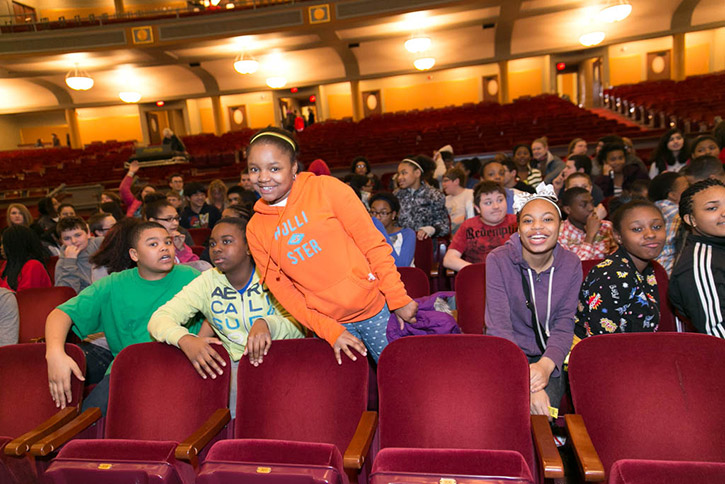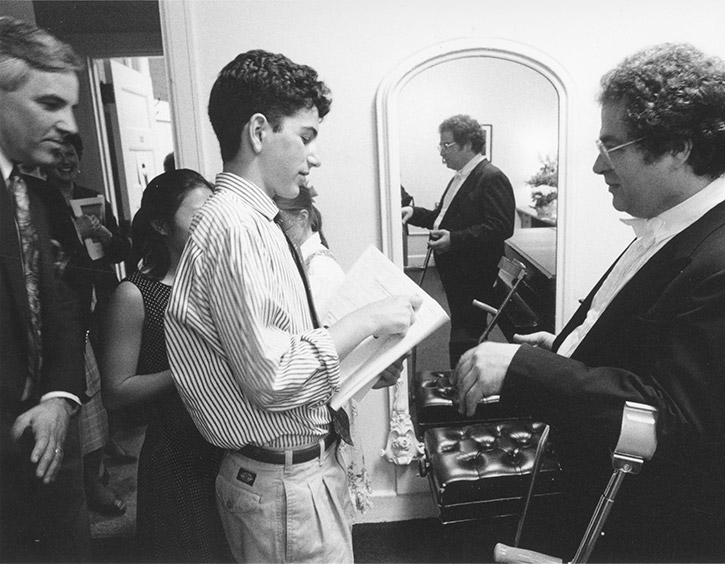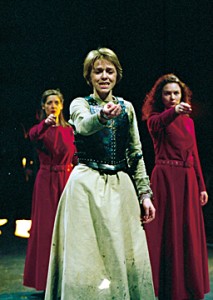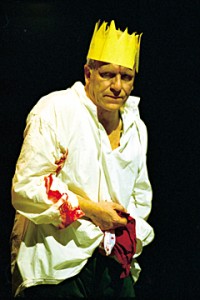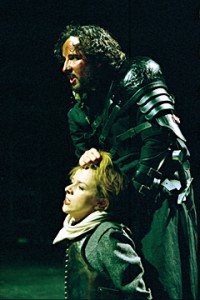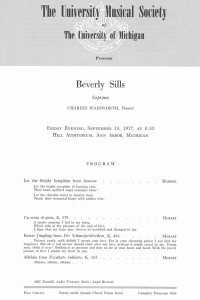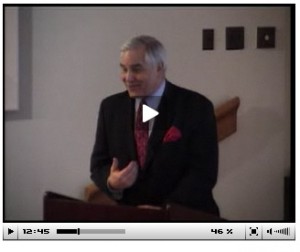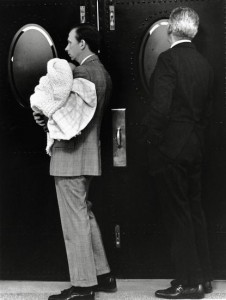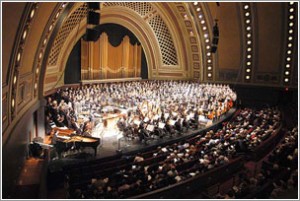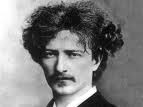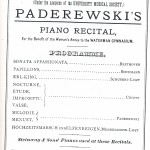School Day Performance with JLCO
The Jazz at Lincoln Center Orchestra and Wynton Marsalis return to Hill Auditorium on March 4, 2016.
The orchestra and Wynton Marsalis have visited Ann Arbor many times since their debut in 1994, and during our 2013-2014 season, the musicians received the UMS Distinguished Artist award. This group is special not only because of their superb music making; the orchestra’s dedication to education programs is also remarkable.
Check out these photos from a School Day performance during our 2013-2014 season. The orchestra on stage:
Wynton Marsalis chats with students after the performance:
Happy students in the auditorium:
Photos by Mark Gjukich Photography.
Last updated 4/29/2016.
From Our Archives: Valery Gergiev
The Mariinsky Orchestra returns to UMS on January 24-25, 2015. The Mariinsky Orchestra (then Kirov Orchestra) first performed in Ann Arbor in 1992. In this 1998 photo from our archives, conductor Valery Gergiev listens to the orchestra in Hill Auditorium in preparation for their performance: 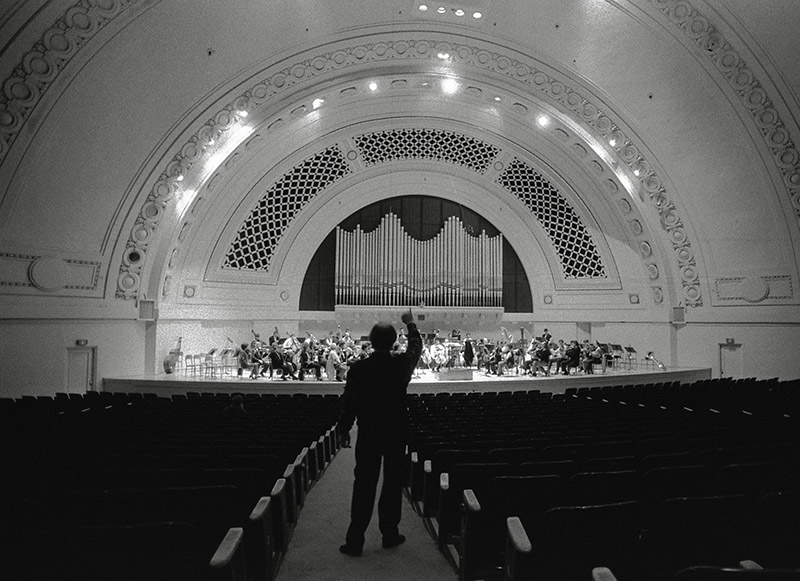 Interested in more from our archives? Check out our digital archives at umsrewind.org.
Interested in more from our archives? Check out our digital archives at umsrewind.org.
Michael Tilson Thomas at 1988 UMS May Festival
We’re getting ready for another visit from San Francisco Symphony on November 13 and 14, 2014. This visit celebrates the 70th birthday of music director Michael Tilson Thomas, and we wanted to share two archival photos from another performance featuring conductor Michael Tilson Thomas, the 1988 UMS May Festival.
In this photo, the Pittsburgh Symphony performs at 1988 May Festival with Michael Tilson Thomas conducting.
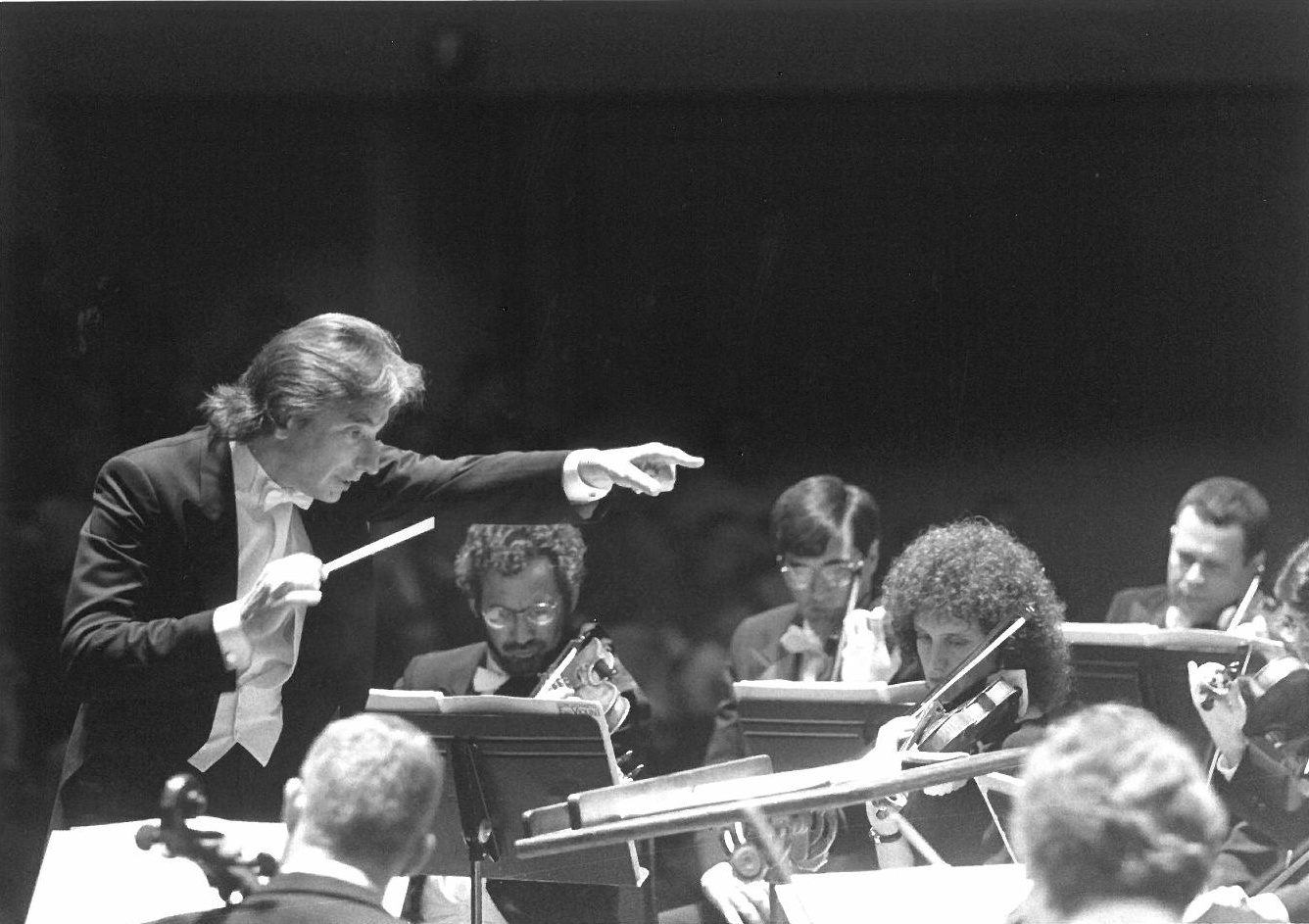
Michael Tilson Thomas signs autographs backstage in Hill Auditorium.
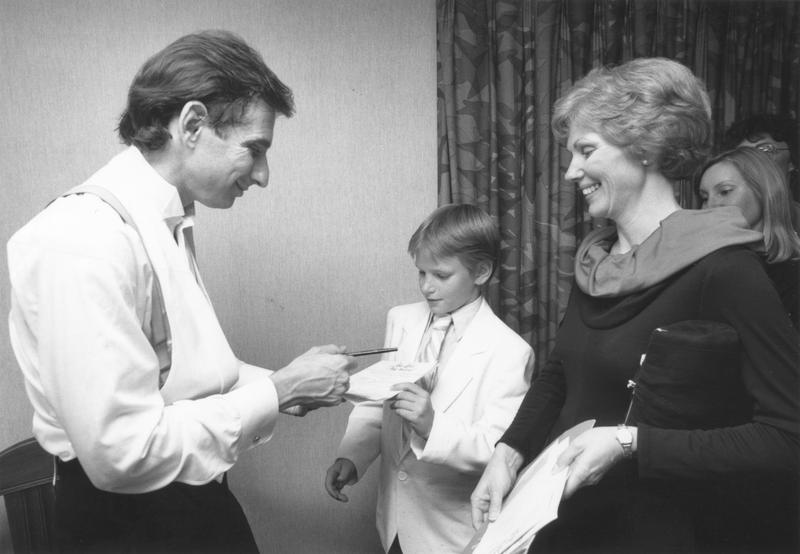
To learn more about the May Festival’s one-hundred year history, watch “A Space for Music, A Seat for Everyone,” our feature documentary about Hill Auditorium.
Interested in more from our archives? Check out our digital archives at umsrewind.org.
From Our Archives: Itzhak Perlman
Violinist Itzhak Perlman returns to Hill Auditorium on September 14, 2014.
Itzhak Perlman made his UMS debut in April 1970 with the Philadelphia Orchestra. From our archives, a backstage photo from his visit during the May Festival in 1993 (that’s UMS president Ken Fischer on the left!):
Interested in more from our archives? Check out our digital archives at umsrewind.org.
From Our Archives: Israel Philharmonic Orchestra visits Ann Arbor
The Israel Philharmonic Orchestra returns to Hill Auditorium with long-time conductor Zubin Mehta on March 15, 2014 (they’ll perform Bruckner Symphony No. 8).
From our archives, a photo from the orchestra’s visit to Ann Arbor in 1972.
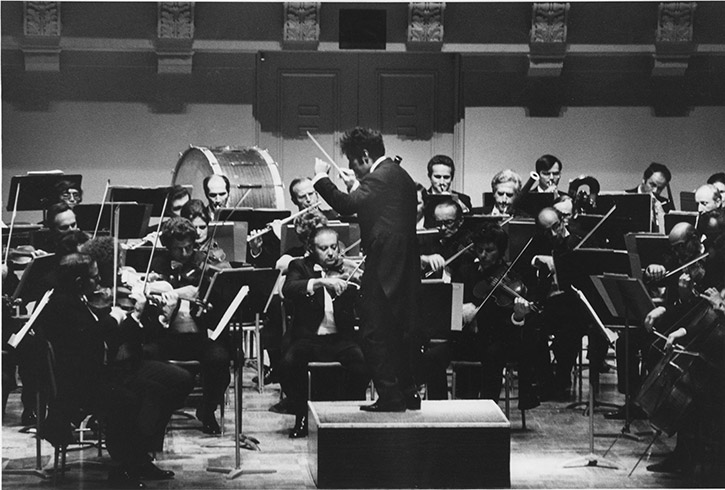
In another visit in 1989, here is conductor Zubin Mehta with his wife U-M alumna Nancy Kovack as they visit with U-M president James Duderstadt and wife Anne Lock-Duderstadt at the president’s house.
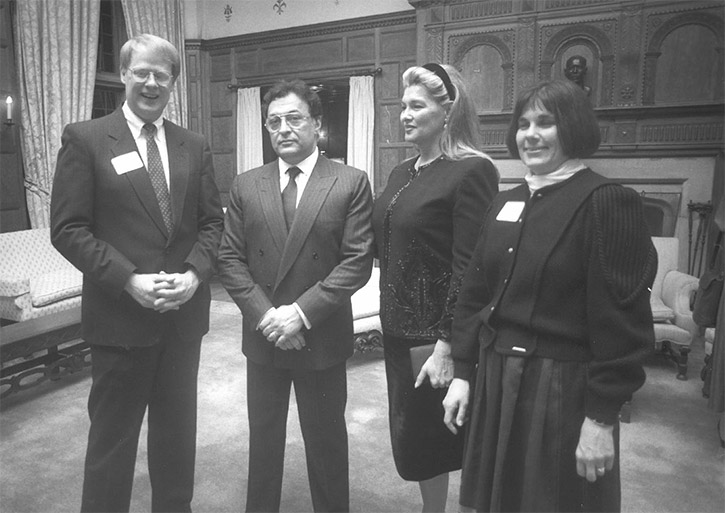
Later, during a visit to the Martha Cook dormitory, the home of Nancy Kovack during her time at Michigan.
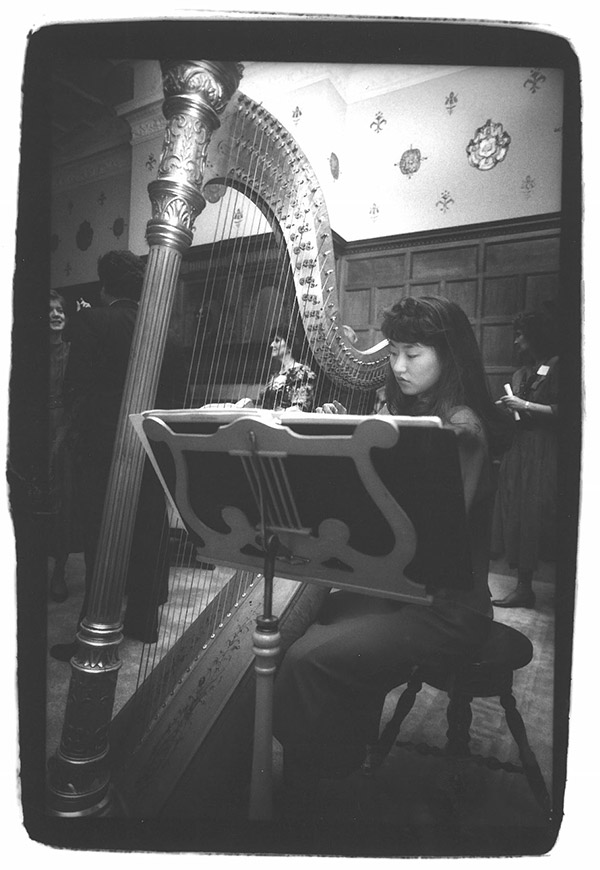
Finally, the contact sheet from that performance gives a sense of the bustle backstage at Hill Auditorium.
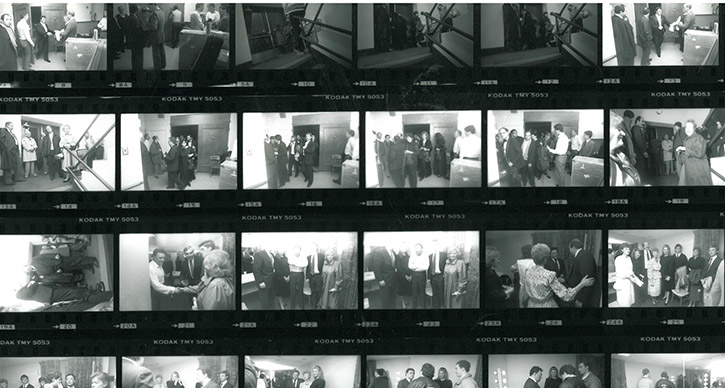
Yuri Temirkanov Visits Ann Arbor in 1996
The St. Petersburg Philharmonic returns to Hill Auditorium with long-time conductor Yuri Temirkanov on February 22, 2014.
From our archives, a photo from of conductor Yuri Temirkanov’s visit to Ann Arbor in 1996. Here, he is in rehearsal with U-M University Symphony Orchestra:
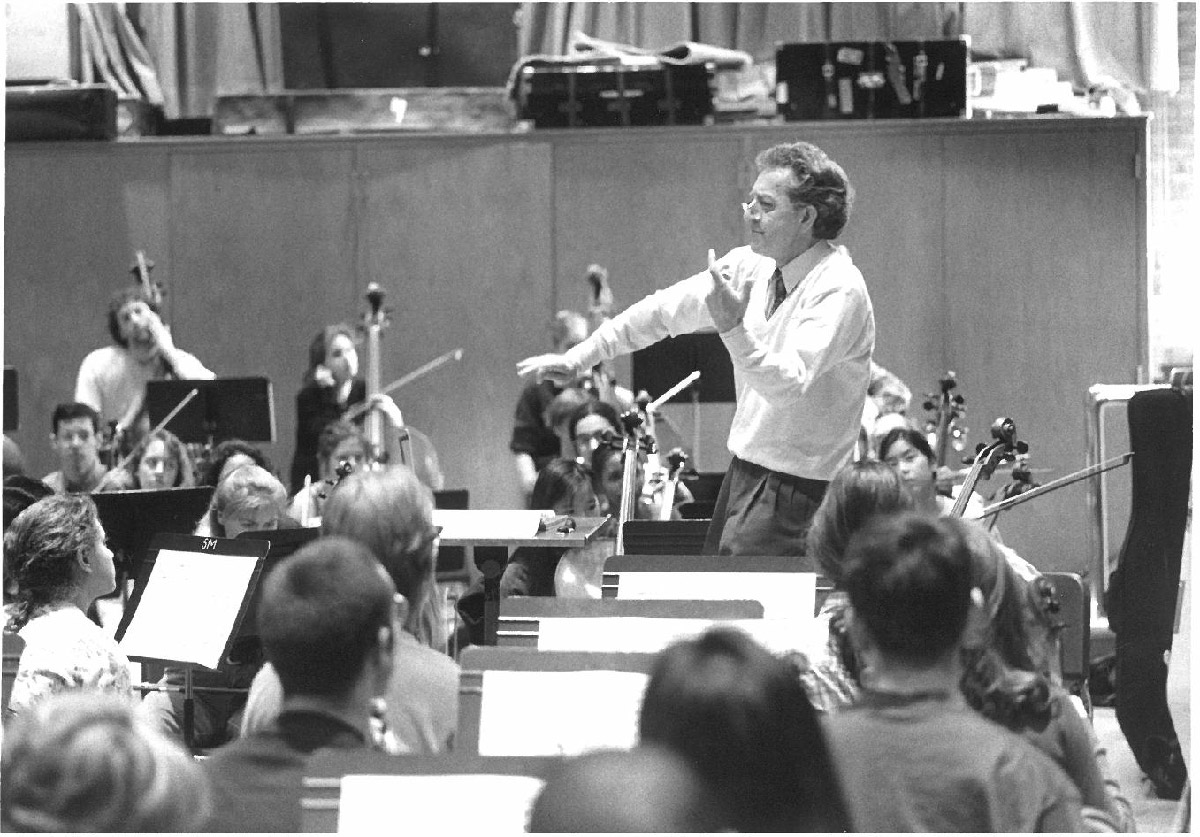
Explore other photos in our archive.
This Day in UMS History: Royal Shakespeare Company History Plays (March 10-18, 2001)
Ten years ago today, UMS audiences began a great experiment — the Royal Shakespeare Company presenting four Shakespeare History plays (Henry VI, parts i, ii, and iii, and Richard III) over the course of 27 hours with lunch and dinner breaks built in. The productions, directed by now-RSC artistic director Michael Boyd, marked the beginning of a long relationship between the University of Michigan and Ann Arbor with the RSC. Over the past decade, this partnership has included three major residencies, as well as workshopping new plays on the U-M campus. Each residency was accompanied by dozens of free educational events for students and the public-at-large.
Those who were present will no doubt fondly recall some of these images from the productions:
The three Henry VI plays were presented at 11 am, 2 pm, and 8 pm on a Saturday, with audiences returning on Sunday for the climactic production of Richard III. (There was also one mid-week cycle, which ran Tuesday, Wednesday [both matinee and evening], and Thursday.) Since that season, UMS’s theater programming has expanded significantly, with an annual commitment to presenting both live and high-definition broadcasts of international theater — including this season’s productions of Richard III and The Comedy of Errors by another British theater company, Propeller. Like the RSC, Propeller presents contemporary interpretations of Shakespeare and works with an ensemble cast; unlike the RSC, Propeller uses an all-male cast to present the Bard’s works, as would have been the case in Shakespeare’s day.
Richard III opens at the Power Center on Wednesday, March 30, and The Comedy of Errors opens the following evening. Tickets can be purchased at www.ums.org or by calling 734-764-2538.
This Day in UMS History: Laurie Anderson Meets the Great White Whale (Sept. 30-Oct. 2, 1999)
 Multi-media dominatrix Laurie Anderson opened the 1999/2000 UMS season with three performances of Songs and Stories from Moby Dick in the Power Center. The piece took Melville’s great novel as its inspiration, with Anderson’s signature penchant for the technological edge highlighted by the debut of the “Talking Stick,” a digital sampling machine that could replicate virtually any sound at a granular level. Anderson’s interest in developing the piece evolved because she was working on a project for high school kids about books with another producer (the project never materialized). She chose Moby Dick, remembering the novel’s obsessive captain, but also remembering, with dread, the incredible detail about the whaling industry and its technical paraphernalia. She was completely captivated by the novel as an adult, read it five times, and began to hear the music and lyricism in the author’s voice. From that experience, she began her largest undertaking in 15 years.
Multi-media dominatrix Laurie Anderson opened the 1999/2000 UMS season with three performances of Songs and Stories from Moby Dick in the Power Center. The piece took Melville’s great novel as its inspiration, with Anderson’s signature penchant for the technological edge highlighted by the debut of the “Talking Stick,” a digital sampling machine that could replicate virtually any sound at a granular level. Anderson’s interest in developing the piece evolved because she was working on a project for high school kids about books with another producer (the project never materialized). She chose Moby Dick, remembering the novel’s obsessive captain, but also remembering, with dread, the incredible detail about the whaling industry and its technical paraphernalia. She was completely captivated by the novel as an adult, read it five times, and began to hear the music and lyricism in the author’s voice. From that experience, she began her largest undertaking in 15 years.
This production was Laurie Anderson’s UMS debut (she has since appeared in 2002 with Happiness and in 2004 with The End of the Moon, and returns in January with Delusion). As a relative newcomer to the staff at that time, I traveled a few months before her Ann Arbor production to see the work in Philadelphia, at the Prince Theater. A night or two before I saw it, the actor playing Captain Ahab miscalculated the edge of the stage and fell into the orchestra pit, breaking his leg. I don’t recall the details of what happened that particular night — I think they canceled the performance — but by the time I arrived in Philadelphia, the actor was back on stage, manipulating his crutches through a surprisingly complicated stage choreography and making it seem as though that had been part of the design from the beginning. It turns out that although Captain Ahab is probably the most famous one-legged captain in literature, Anderson’s team had not considered using crutches until the accident forced the issue. By the time I saw the production in Ann Arbor several months later, the crutches had become an integral prop, perfectly incorporated into the storytelling.
Anderson’s ironic sense of humor permeated Moby Dick. In the program notes for the work, she noted, “Being a somewhat dark person myself, I love the idea that what you look for your whole life will eventually eat you alive.”
This performance brings back so many strong memories for me: how gracious Laurie Anderson was to break from tech rehearsals to give an interview to a public television TV show, how she willingly went to Detroit for a 20-minute interview on WDET, her generosity in allowing selected classes to see a dress rehearsal of the work in tech week. I also remember seeing an internet ticket order come in from somebody who lived in the same small town in Wisconsin where I grew up. This was in the early days of e-commerce, and it was shocking to see an address that was literally down the street from my childhood home, from someone renting an apartment in my late great-uncle’s house. Songs and Stories from Moby Dick was an incredible introduction to Laurie Anderson’s work and an amazing way to kick off the UMS season.
This Day in UMS History: Beverly Sills (September 23, 1977)
This Day in UMS History – September 23, 1977
Hill Auditorium
Beverly Sills, soprano
Charles Wadsworth, piano
Let the Bright Seraphim from Samson–Handel
Un moto di gioia, K. 579–Mozart
Bester Jüngling from Der Schauspieldirektor, K. 486–Mozart
Alleluia from Exsultate Jubilate, K. 165–Mozart
Many artists presented by UMS over its 132-year history have a long and rich history of performances with the organization. Soprano Beverly Sills was certainly no exception. Throughout the 1970s, Beverly Sills made numerous appearances under UMS auspices, culminating with this, her final appearance in 1977, just a few short years before announcing her retirement in 1980.
The late 60s and early to mid 70s were considered the high points of Beverly Sills’ career, as evidenced by her appearance on the cover of Time magazine in 1971, where she was described as “America’s Queen of Opera.” Beverly Sills’ first UMS appearance on January 30, 1971 was also a solo recital with Charles Wadsworth accompanying her on piano. On that particular program, Sills sang three arias from Handel’s opera seria Giulio Cesare. It is interesting to note that in 1966, Sills’ performance as Cleopatra in the New York City Opera’s revival of Handel’s then virtually unknown Giulio Cesare, is what many argue made her an international opera star.
Her final UMS program featured an aria from Handel’s oratorio Samson, considered by many to be one of Handel’s finest dramatic works, as well as three pieces by Mozart: concert aria “Un moto di gioia”, “Bester Jüngling” from the comic singspiel Der Schauspieldirektor (one of the only four vocal numbers in that piece), and “Alleluia” from the final allegro section of Mozart’s religious solo motet Exsultate Jubilate.
Following her retirement from performing, Beverly Sills remained quite active with the New York City Opera, serving on their board until 1991. Following that, she also served as chairman of Lincoln Center until 2002, and then as chairman of the Metropolitan Opera. Beverly Sills lost her battle with lung cancer on July 2, 2007 at the age of 78.
I hope you will take a moment to enjoy the video below and hear for yourself (if you weren’t able to attend any of her UMS performances!) the beauty and purity of tone of Beverly Sills’ voice as she sings one of my all-time favorite Mozart arias “Ruhe sanft, mein holdes Leben” from Zaide.
Search Hundreds of Photos… and 100 Years of Concert Programs
Finally–the time has come! Thanks to the Ann Arbor District Library, we launched the beginnings of the UMS digital archive!
UMS President Ken Fischer launched the archive March 14, 2010, with a special talk about UMS’s history. You can watch the whole thing here:
The AADL has digitized the first 100 years of UMS concert programs as well as hundreds of photos from our photo archive. It’s a work in progress, but we couldn’t wait to share it with you.
The AADL is building a searchable database so that we can link all of this great history together. We’re also continuing to scan and tag photos, and making plans to digitize our old-fashioned card catalog of artists and repertoire, so that you can pick your favorite symphony and search for every time it was performed on our stages and by whom!
A quick walk through of the site.
Along the left hand side, you’ll see a menu with a few options:
Browse Programs: Here, you’ll find a comprehensive list of every concert from our first season through the 1978/1979 season. Click on a program, and you’ll see images of the concert program. Click on the images, and they will enlarge and given you an option to view them in full-screen.
Search Programs: Here, you’ll find a simple search box. Type in a keyword: a date, artist, piece title, composer, venue–click “search,” and it will pull up every program that matches your keyword. (Remember–it only covers programs through the 1978/79 season so far.)
Browse Images: My favorite! Scroll down to the search box and type in a keyword–an artist, company, venue–and it will pull up any photos that are tagged with that keyword. For example–if you type in “Bernstein”–you’ll see photos of Leonard Bernstein, photos of the Bernstein benefit, and tons of scanned contact sheets from his Ann Arbor visits (some of which only a few people have ever seen before!). Click on a photo to enlarge it. NOTE: When your search results appear, make sure to click the button under the search box that says “Show all #” as there may be more photos than the three that appear.
We hope you enjoy playing around with the site, and remember, there is MUCH MORE to come! Thanks so much to our great partners at the Ann Arbor District Library for helping us share our history. Stay tuned!
This Day in UMS History: Royal Philharmonic Orchestra (Feb 19, 1985)
Editor’s Note: Royal Philharmonic Orchestra performs in Ann Arbor on January 11, 2016.
February 19, 1985
Hill Auditorium, Ann Arbor
Royal Philharmonic Orchestra
Yehudi Menuhin, conductor
“While Yehudi Menuhin’s name is synonymous with the violin, he is also regarded as one of today’s finer conductors.” So begins the biographical note for the concert of this orchestra, which in 1986 counted André Previn as its Music Director and the Queen Mum as its patron. Menuhin’s name is indeed synonymous with the violin, but even for a violinist he had an unusual life. He was raised in California, studied in Europe with Georges Enesco, and as a teenager was an internationally famous violinist. During World War II, he flew, sometimes in dangerous conditions, to military hospitals to perform for wounded soldiers – acts for which France later honored him with the Legion of Honor (making him its youngest recipient). He was a close friend and collaborator with famous Indian sitarist Ravi Shankar (who, still going strong at 90 years old, recently appeared at Hill with his daughter Anoushka) and released joint recordings with legendary jazz violinist Stephane Grappelli. He founded the Yehudi Menuhin School in Surrey, England, received fourteen honorary doctorates, and was made a life peer by Queen Elizabeth II. He died in 1999.
“This day in UMS History” is an occasional series of vignettes drawn from UMS’s historical archive. If you have a personal story or particular memory from attending the performance featured here, we’d love to hear from you in the comments.
What Are YOUR Most Memorable UMS Performances?
This Day in UMS History: “Paderewski’s Piano Recital” (Feb 15, 1892)
February 15, 1892
University Hall, Ann Arbor
During my time at UMS, I’ve become used to seeing the ghosts of famous musicians. I’ve stumbled across signed photos of Jascha Heifetz (for whose violin classes current U-M Professor Martin Katz played) and records of Sergei Rachmaninov’s appearances at Hill. Even so, I did a double take when I found the program for Ignace Paderewski. The billing simply said “Paderewski’s Piano Recital”, adding that it was “For the Benefit of the Woman’s Annex to the WATERMAN GYMNASIUM.” I figured it was a society named after the Polish composer-pianist, and was very excited to discover that it was in fact a recital by Paderewski himself. I was even more excited to learn more about this pianist – I knew from Arthur Rubinstein’s memoirs that he was an inspirational pianist, mentor, and composer – but I also found out that he was an ardent Polish patriot, and was even Prime Minister of Poland for a brief time.
His recital program was formidable (Beethoven, Schumann, Chopin, Liszt transcriptions of works by Schubert and Mendelssohn, and his own compositions), as befits a pianist who had just conquered the musical capitals of Europe (UMS’ archives includes a biography of Paderewski by a London reviewer) and was in the process of doing the same to America’s musical capitals – then as now including Ann Arbor. Paderewski returned to Ann Arbor five more times, the last in 1933. He died while on tour in New York City in 1941. He was buried in Arlington National Cemetery until 1992, when his remains were brought to Warsaw.
“This day in UMS History” is an occasional series of vignettes drawn from UMS’s historical archive. If you have a personal story or particular memory from attending the performance featured here, we’d love to hear from you in the comments.
Welcome to umsLOBBY.org!
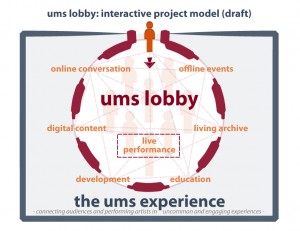 In June 2009, UMS was one of four organizations awarded an “Innovation Lab” grant by EMCArts, with support from the Doris Duke Charitable Foundation. The grants were awarded to allow organizations to develop an idea that could have a profound impact on how they do business.
In June 2009, UMS was one of four organizations awarded an “Innovation Lab” grant by EMCArts, with support from the Doris Duke Charitable Foundation. The grants were awarded to allow organizations to develop an idea that could have a profound impact on how they do business.
During the summer, a team of UMS staff members and volunteers researched new ideas related to social media. A week-long intensive retreat in October resulted in further development of this project. We’re now prototyping the UMS Lobby project with this new website and blog, and with several live events that will happen during the next three months as we wrap up the 09/10 season.
The UMS Lobby will expand and redefine what we mean by “the UMS experience.” By combining online and live components in everything UMS does, we’ll enable a greater amount of people to engage more continuously and deeply with each other, with the extraordinary history of UMS, with the artists we now present, and with the life of UMS in Ann Arbor and throughout the region.
The UMS Lobby is a place where people meet, exchange ideas, and build relationships — a bridge between daily life and the special places we devote to artistic experiences. UMS has many “lobbies,” and we’ll use these physical spaces in new ways to welcome our audiences and invite them to learn from us and from each other. And, of course, the learning goes both ways — we at UMS always find that we learn so much from you, our audiences, whenever we have the opportunity to meet up socially.
At the same time, the UMS Lobby is a virtual space, accessible year-round, where we will offer multiple streams of activity to engage anyone interested in art and ideas, or in UMS specifically. Among the virtual offerings — some of which are already active, and some of which are still in development:
- A multimedia blog with text, video, audio, photos, and links (that’s what you’re reading now!)
- Conversation areas that include feeds from our facebook, twitter, and other networks, but that also provide a place to listen and to be heard
- A digitized historical archive that includes access to UMS’s extraordinary 131-year history, including the opportunity to submit your own comments, memories, and observations about events that you’ve attended. We’re working closely with the Ann Arbor District Library to bring this project to fruition.
- Stories from patrons and others about the impact of UMS —in essence, a “living archive” that will grow with time and supplement the historical archive
So what does this mean for the regular UMS website? You can continue to visit www.ums.org for all of the information you need about UMS and upcoming events — sound clips, video clips, program notes, and information about purchasing tickets. Think of ums.org as a site filled with information, and umsLOBBY.org as a site filled with conversation.
So what do you think? What do you want to read more about? Let us know — we want to hear from you!
See you in the “Lobby”!


